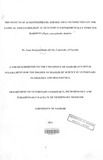| dc.description.abstract | Malaria and schistosomiasis are the two most prevalent parasitic infections in the tropics and subtropics. Both diseases share similar epidemiological distribution and therefore co-infections frequently occur. Plasmodium Jalciparum and Schistosoma mansoniare the major species that cause considerable morbidity and mortality in humans malaria and schistosomiasis, respectively. However, the impact of co-infection of the two diseases has not been elucidated fully. The objective of this study was to investigate the effects of schistosomiasis and malaria co-infection on the clinical and pathological disease outcomes, using the baboon as an animal model.
Twenty seven (27) baboons, that had been screened and confirmed free of both schistosomiasis and malaria were used in this study. Five hundred (500) schistosoma cercariae were percutaneously administered to induce schistosomiasis. Blood stage P. knowlesi parasites (1 x 104) were used to induce malaria. Four experimental groups were used in the entire study. Group A comprised three baboons that were infected with schistosomiasis alone. Group B consisted of eight baboons that were infected with schistosomiasis and then infected with malaria on the 19th week of the experiment and remained untreated for both diseases.
Group C comprised eight baboons that were first infected with schistosomiasis, treated for the disease using praziquantel on the 14 and 15th week of the experiment, and then infected with malaria on the 19th week of the experiment (in the chronic phase of schistosomiasis). All eight animals in Group D were infected with malaria alone.
All animals were monitored daily for clinical signs associated with either of the disease and at the end of the experiment, post mortem and histopathology was done to assess disease severity. The severity of malaria as a single infection or as a co-infection with schistosomiasis was determined by assessing the onset of disease, clinical manifestations and organ pathology at postmortem. Indicator clinical signs for the onset of malaria were lethargy, reduced physical activity, reduced feed intake and manifestation of hunched over position characterized by prolonged sitting. Clinical signs of severe malaria were hemoglobinuria, vomiting, anemia, respiratory distress and early deaths.
Severity of schistosomiasis either alone or as a co-infection with malaria, was indicated by bloody diarrhea, schistosoma worm burden and pathological lesions of schistosomiasis in the liver and the colon. The histopathological assessment of disease severity included counting the number of schistosomiasis egg-induced granulomas in the liver and colon, measuring the size of granuloma and counting the number of eosinophils within these granulomas.
Animals infected with schistosomiasis alone (Group A), developed the acute phase of the disease that was characterized by bloody diarrhea followed by an asymptomatic chronic phase. Animals in this group showed severe schistosomiasis egg-induced lesions characterized by significantly increased (p<O.05) number of hepatic granuloma and counts of eosinophils in these granulomas compared to either Group B or C.
The number of schistosomal eggs lodged in colonic wall was also significantly high (p<O.05) compared to either Group B or C. There were no mortalities in this group. Animals in Group B that were co-infected with schistosomiasis and malaria developed mild clinical signs of disease characterized by delayed onset, low mortalities and mild organ pathology. This Group also showed less severe schistosomiasis egg-induced hepatic lesions with significantly (p<O.05) fewer hepatic granuloma, low occurrence of eosinophils in those granuloma and fewer eggs lodged in colonic wall compared to Group A.
Animals in Group C that was treated for schistosomiasis then infected with malaria developed moderate clinical signs of both malaria and schistosomiasis with low mortalities. Group D animals manifested severe malaria with high mortality. From this study it was concluded that treatment for schistosomiasis aggravated clinical outcome of malaria. Induction of malaria to baboons with chronic schistosomiasis caused a reversal to the acute phase of the disease in two out of the eight schistosomiasis infected baboons. Results from this study indicate that schistosomiasis and malaria co-infection influenced the clinical and
pathological outcome of either disease. | en_US |

